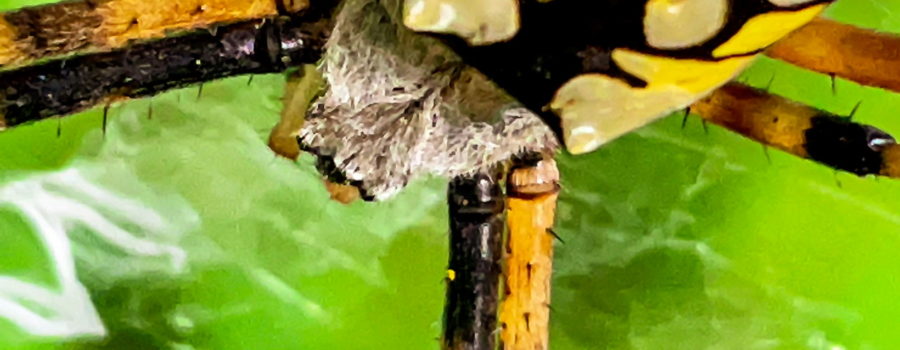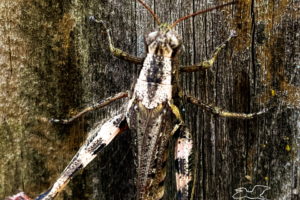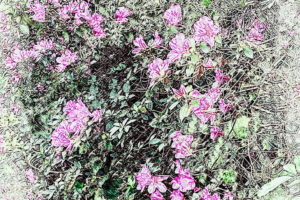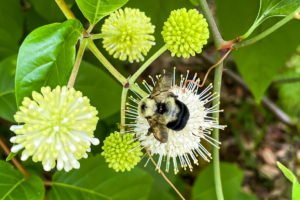The Yellow Garden Spider is Great for Gardens and Yards

Back in May, I wrote about the banded garden spider (Argiope trifasciata), which is an orb weaver spider that is often found in gardens, fields, and woods edges. I found and photographed one on my way into town to do some errands. I had stopped to get some shots of the prickly poppies that were all alongside the roads at that time, and ended up finding a whole bunch of other interesting stuff as well. Not too long ago, I was in my own yard, trying to get some good shots of several types of butterflies, wasps, and bees that were enjoying the blackjack, when I just about walked into the web of another orb weaver. In fact, the web I almost walked into looked exactly like the webs of the banded garden spiders, and the spider looked very similar, too. At first, I thought it was a banded garden spider, when I saw the bottom side, but when I went around the web and saw the top of the spider I realized that it wasn’t. This spider had a flattened, slightly fuzzy grey head, which the banded garden spider definitely did not. The markings on the abdomen were also somewhat different, but very similar to those of the banded garden spider. Obviously, the two must be closely related.

And, of course, they are. This spider turned out to be a yellow garden spider (Argiope aurantia), also known as a black and yellow garden spider, golden garden spider, corn spider, zipper spider, or zigzag spider. As you can see, these spiders are two different species within the same genus. Both of these spiders live in similar habitats, and have many very similar behaviors. Like the banded garden spiders, the yellow garden spiders are common throughout North America, south into Central America, and even into northern South America. While banded garden spiders are more commonly seen in the spring and summer, the yellow garden spiders are seen mainly in late summer and early fall.

As I stated earlier, these two spiders (and several of the other orb weavers, as well) make a complex circular web that is based around several long spokes. The interesting thing, though is a thick, highly visible zigzag area in the center of the web called a stabilimentum. No one really knows why they build the stabilmentum, but there are several theories. It may help to stabilize the web and make it stronger so that larger insects don’t destroy it when they get caught. More likely, it may be to increase the visibility of the web to larger animals like birds and nature walkers. That way we know to go around rather than plunging through and ruining the web. I can say that the whole way I noticed this particular spider was that I saw the stabilimentum. I know that means a spider web and began looking for the spider.

Like all of the orb weavers, these spiders catch their prey in their beautiful webs. When an insect hits the web, the spider runs to it from the web center and bites and paralyses it. Then it either begins to eat it or more likely, it will wrap the bug up in silk to save it for later. Also like the other orb weavers, the yellow orb weaver is nonaggressive towards humans and pets. It will only bite if totally harassed or squashed. But even if it does bite, it’s venom is not harmful to anything larger than a small lizard. If you do get bitten, the bite will sting and burn for a few minutes, but that will be the extent of it unless you are highly allergic. One thing that yellow orb weavers like to do that sets them apart from many of the other orb weavers is that they will sometimes drop out of the web into the undergrowth. They remain attached to the web by a thin strand of silk and through that they can feel the vibration caused by an insect hitting the web. It’s amazing how quickly the apparently absent spider can suddenly reappear when the web vibrates!

There are plenty of orb weavers that live in Florida, but every time I discover a new one living in my yard or around in the central Florida area, I am impressed by how many pest insects they can trap and consume in the course of a year. I am also stunned by their various sizes, shapes, and color patterns. I know that a lot of folks are not the huge fans of spiders that I am, but you have to admit that they are incredibly well adapted to what they do, and they provide a huge service to all of us by catching and eating literally hundreds of flies, gnats, ants, mosquitoes, and other pest insects. Can you imagine what our gardens and yards would be like without spiders?

Do you love beautiful nature photography and artwork? Do you enjoy entertaining and informative nature and animal related content? Well if you do, you’ll love this blog! Subscribe below and check it out!





Recent Comments